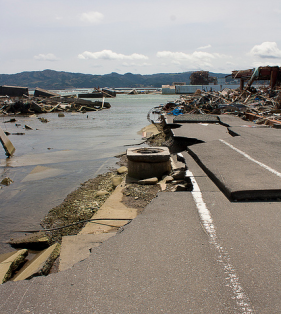
Photo by Daniel Pierce.
When Republicans loaded up a transportation bill with what the NRDC’s David Goldston floridly calls “a gallimaufry of bad ideas” that included the Keystone XL pipeline and oil drilling in the Gulf of Mexico and the Arctic National Wildlife Refuge, it seemed like a cheap political stunt: The monstrosity would never stand a chance of becoming law. Sure enough, the White House has promised to veto the bill should it actually make it through Congress.
The House passed the drilling proposals last Thursday anyway, with help from 21 oil-loving Democrats. (Twenty-one Republicans broke ranks with House leadership, voting against the bill. A handful of them are from Florida, where the $60 billion tourism industry apparently trumps a few extra mil from offshore drilling.)
But amid all the debate over the transportation bill, one truth has gone unsaid — a truth that explains, at least in part, what these proposals are doing in the transportation bill in the first place, and why the lines between opponents and supporters are not more clearly drawn: We have become slaves to our roads.
For those of you who are just tuning in, Republican leaders in the House unveiled a transportation bill earlier this month that was widely hailed as a train wreck. Literally. It would cut all designated funding from mass transit, bike and pedestrian infrastructure, and even a program that creates safe routes for kids to get to school. The proposal was almost completely focused on building roads and highways — and to fund the work, GOP leaders included the pile of oil drilling provisions. Environmentalists called it “drill and drive.”
In the face of widespread opposition (from a coalition of transit and smart-growth advocates on the transportation side, and environmental groups on the drilling side), House Speaker John Boehner (R-Ohio) broke the bill into pieces. The House passed the drilling provisions last Thursday, in the vote that had Democrats and Republicans jumping across the aisle. The transportation aspects will be debated later this month, then the various pieces of the package will be tied up in a bow and sent to the Senate, where, we can hope, cooler heads will prevail.
But don’t we have other ways of paying for our roads and rails that don’t involve giving Big Oil the keys to the kingdom?
Yes and no. We spend an estimated $186 billion each year to maintain our ground transportation system in this country. Despite that, we’re losing ground. The Federal Highway Administration estimates that just getting “structurally deficient” bridges up to snuff will require more than $70 billion.
In the past, much of the transportation system has been paid for using federal and state gas taxes, which now add about 43 cents to the cost of a gallon of gasoline on average. But cars are becoming more efficient, meaning we’re burning less fuel and paying less in gas taxes, and while the cost of maintaining our roads has risen steadily, the federal gas tax has remained the same since 1993. To make matters worse, thanks to a drowsy economy, Americans are driving less and buying less stuff that needs to be shipped cross-country.
What does it all add up to? We either need to jack up the gas tax — not likely during an election year — or find another way to pay for this monster that we’ve created.
To give you a sense for how desperate elected officials have become, several states are considering taxing electric cars — fair enough, as they don’t contribute to gas taxes, but they still represent only a fraction of a percent of the vehicles on the roads.
On the federal level, Sen. Mike Enzi (R-Wyo.) actually suggested raising the gas tax recently, but he quickly dropped the proposal. Rest assured that it will be back in the not-too-distant future, however. Groups as varied as the Natural Resources Defense Council and the U.S. Chamber of Commerce support raising the tax. Failing that, or some other solution, the Congressional Budget Office (CBO) projects that the Highway Trust Fund, our gas-tax bank account, will run dry as soon as this fall.
In the meantime, the circus in Washington continues. President Obama and congressional Democrats (correctly) accuse House Republicans of using their transportation proposal as an excuse to rubber stamp drilling proposals that will likely produce little revenue. (A CBO study finds that, despite the drilling provisions, the House bill would still bankrupt the Highway Trust Fund.) Republicans, meanwhile, say Obama is using fuzzy math in his budget proposal, claiming that we can create money for transportation by spending less on wars overseas.
No one, however, seems to dare to suggest that there is a third way: Let some of our roads go. For all it’s done for us, our auto-centric transportation system has become an albatross around our neck, particularly in tough economic times. Our roads and bridges are crumbling, and it’s not entirely clear whether we’ll be able to find the money to patch them up and keep them going.
Perhaps the wisest choice is to kiss some of our beloved blacktop goodbye. Ultimately, we may have no choice. Besides, the real road to the future looks more like a set of train tracks or a bike lane than that gleaming strip of asphalt that got us here in the first place.



